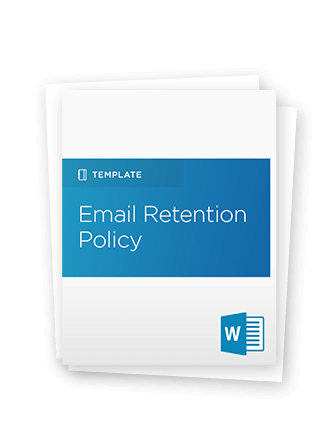How to Improve Email Server Performance Using Email Archiving

Today’s regulatory landscape requires that your organization stay compliant with a litany of laws and regulations related to records management — most notably as it pertains to the data and communication that your employees share both internally and externally via email, chat and more.
But to remain compliant, your organization must store a whole lot of information and ensure its safekeeping for years and years. Storing all this information, while important, is a huge undertaking — one that can have a serious, and potentially detrimental, impact on the performance of your email server.
Common Causes of Email Server Performance Issues
One of the biggest reasons for email server issues isn’t related to the physical server itself, it’s the sheer volume of emails and information being stored on it that is having the biggest impact.
Emails themselves use up almost no space on the email storage server. It’s the attachments (documents, presentations, contracts, images, reports, plans, spreadsheets, etc.) that take up 90% of the typical storage space. This is because email is available from everywhere, and thus the attachments are available everywhere as well. Here’s a great example of what we mean:
A salesperson is working on a presentation for an important client. After completing work on the presentation, he emails it to his boss for review. At this point there is one copy of the presentation in the email server. The boss reviews, makes changes, and sends it back. Now there are two copies on the email server. The salesperson corrects the formatting and sends an email to himself before catching a plane to meet the client. Now there are three copies on the email server. At the client site he goes to his email and finds the presentation. After the meeting he sends a copy to all the attendees. At the end of the process, you’ve got four copies of the same presentation stored on the email server.
This same scenario is being played out every day in businesses across the world, and IT departments are seeing an extreme load on their email servers because of the high disk utilization. At the same time, IT departments are attempting to troubleshoot server problems, and they are being asked for bigger mailbox sizes and better performance. These are mutually exclusive goals – because increasing email server performance while at the same time increasing mailbox sizes is counterintuitive.
On top of all of this, an email server hardware/software refresh is out of the question. The email servers will not get new hardware every time the end users need more space. The usual IT department answer is to impose strict quota limits. Problem solved – less disk utilization and improved email server performance. Now, the problem is the good old PST files. Ask any IT person and you will hear horror stories about PST files.
Fortunately, there is a way to improve the performance of your email server and ensure your organization’s email communication is safely stored for compliance purposes.
Email Archiving: An Important Email Storage Solution
One of the most important elements of managing your email server performance is assessing your email archiving capabilities. If you’re not properly archiving your email communications, your server can become stressed, which can lead to less than optimal server performance. This not only wastes your valuable time, but can also cost you money.
A properly implemented email archiving solution improves performance by providing an archiving architecture and improves space by offering deep storage – capturing all of the incoming and outgoing emails. It stores them, indexes their content and keeps them all in safe email storage. All of the existing emails that are on the mail server are loaded onto the database during a process called the initial load.
While it may seem likely that your organization’s in-house IT department can handle almost any email server management issue, the best solution is to implement a third-party archiver.
Why You Should Avoid Improper Archiving Hardware/Software
A lack of proper equipment and IT infrastructure can also inhibit your email server performance. Improper archiving hardware and software can cause there to be too little space on your email servers, which leads to too much information for your hardware to manage efficiently. You can avoid problems by having a solid plan for the rapidly changing data landscape, one that achieves archiving and information storage compliance.
The following are some of the most common problems when using something other than a third-party email archiving solution:
Too Little Space — Email communication takes up a large amount of storage space. When you add media attachments to emails, even small businesses quickly generate terabytes of information. The lack of a proper email archiving solution can cause many issues for a company wanting to maintain compliance or keep records for posterity.
These issues include the following:
- No Redundant Systems – When email archiving is done in house, it is difficult to obtain the necessary storage space with cloud level redundancies to prevent catastrophic data loss in the event a server crashes.
- Outdated Hardware – Compare the best servers of 15 years ago with technology today. You will discover that the storage space and processing speed of a $10,000 enterprise server from 15 years ago will be beat by today’s $800 personal computer. Understanding the hardware and software systems to operate your email archives requires up-to-date solutions that many small businesses, local government and schools cannot afford.
Not Prepared for Rapid Pace of Data Expansion — Data is expanding in both types and amount throughout the internet and email communications. Although many data changes in the last decade have not affected email archiving, there are many questions that remain about the integrated communication systems businesses are using to manage their email, video chat, phone conversation and more. Understanding FOIA archive rules, eDiscovery archive requirements and business record keeping takes special attention to detail for organizations.
Questions regarding archiving systems and technology will need to be constantly addressed by your business and by your archiving solution designers. These questions include:
- What data needs to be archived? Data includes emails, but can also include chat histories from messaging services. Potential data includes recorded phone conversations, video conferences and other media-rich communication methods.
- What type of data is integrated with our email? Video, 3D images, photographs, audio — the list of possible data types your email service uses goes on. Managing this data is essential to keeping your server capital down, increasing the life of your servers and using as little space as possible with your email solution.
Because your company is continually creating and using more data, your email server and software performance must be continually evaluated and updated to ensure maximum profitability, security and access.
Unexpected Compliance Software and Hardware Costs — Archiving and data management to achieve compliance is a significant part of any organization or business’ technology costs. Maintaining all of your email on your main server is costly in terms of data space and clogging up your hard drive speed.
The most effective email solutions are integrated across the board with other software systems. This integration gives you the tools to automate archiving, categorization of emails, due diligence and discovery investigation.
As your business grows, your email service needs to grow with it. Data use will increase with your growth as it will increase with time and the growth of electronic mediums of delivering information and communication.
What to Look For in an Email Archiving Solution
Email is quickly replacing snail mail, telephone and even face-to-face conversations in today’s technological work environment. Because so much communication happens over email between your employees, customers and other constituents, searching and organizing this information requires special forms of software, hardware and archiving systems.
Information overload happens quickly in a data-rich environment like email archiving. This creates the necessity for building a business system with the right tools to not only manage your server space, but also decrease your labor costs and your email server costs.
A proper email archiving solution will include: the following tools:
- Business Intelligence (BI) – BI is the application of large-scale data algorithms to business information. Think Google for your email archives. In order to manage your BI well, you will need to have the right software and algorithms to find the information you are looking for.
- eDiscovery Overviews – Anyone with the bad luck of being in a lawsuit involving electronic communication knows the hassle of eDiscovery. The costs associated with finding all the information relevant to the case at hand can be astronomical. A good information management system will have already categorized your email archives and will give you the tools to easily find the information and communications you need.
- Intuitive Client Side Controls – Client-side controls are what you see when you log into your email archiving solution. In order to efficiently manage your archive you must be able to understand the tools you are using.
These are just three of the features you’ll want when implementing an email archiving solution for your business or organization. If you are looking for a partner who has experience with email archiving solutions and consistently addresses these issues to reduce the stress on your email servers through best-in-industry archiving, consider Intradyn. A leader in the archiving industry for many years, Intradyn has the email archiving solutions to fit your needs.
Contact us today to discover how to archive your emails.

